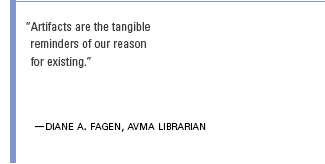AVMA preserves pieces of the past

At AVMA headquarters, the halls and the walls are full of historical artifacts with stories to tell.

From conventions come pins, medallions, stuffed animals, paper hats, sepia photographs, programs, and even menus. From around the globe come statues, banners, awards, documents, a musical clock, and other gifts and greetings. From down the decades come books, journals, proceedings, directories, and a printing block for a newspaper advertisement.
"Artifacts are the tangible reminders of our reason for existing," said Diane A. Fagen, AVMA librarian.
The House of Delegates amended the bylaws last summer so members can celebrate the 2013 sesquicentennial convention in Zone 2, home of the AVMA—reordering the regular rotation among three geographic zones. And historical artifacts will play a part in commemorating 150 years of veterinary medicine.
One veterinarian's story
Many of the AVMA artifacts bear the original emblem of the profession, including one precious piece of the past. The most recent addition to the collection is a 60-year-old brooch depicting the former emblem in gold, diamonds, and emeralds.
Like every AVMA artifact, the pin also tells another story. The brooch once belonged to Dr. Janet Willetts, who died last year at age 82 after a long career in veterinary medicine.
Dr. Willetts started down the path toward the profession as a young girl, said her sister, Marjorie Maiden. The future veterinarian walked all of the neighbors' dogs in the mountains near Montreal, and she decided to become a dog nurse. When she learned that the job just didn't exist, she decided to become a veterinarian.
Dr. Willetts attended Cornell University at first, but she and other female students felt they ran into resistance from the male students. For example, the male students who corrected the papers allegedly threw away the female students' papers. At about the same time, Maiden said, Dr. Willetts started going by "Kerry" because the name could be a man's or a woman's.
Nevertheless, Dr. Willetts chose to return to Canada. She earned her degree from Ontario Veterinary College in 1945. As a graduation gift, her parents commissioned a pin from Birks of Montreal.
The brooch soon accompanied Dr. Willetts to Los Angeles, where Maiden had built her a hospital. The sisters ran the clinic together for years. Dr. Willetts, who loved acting as well as animals, met movie stars who brought their pets to the practice.
Along the way, Dr. Willetts also befriended several veterinarians from Sweden, including Drs. Sten-Erik Olsson and Gunnela Ljunggren. She traveled to Sweden and learned to speak the language. She insisted that if her Swedish guests in California spoke to her in English, they had to buy dinner.
Dr. Willetts offered rabies clinics at night across California, too, and she was active in the Southern California VMA. Through the SCVMA, she also started going on house calls. Under pressure by developers to sell her property, she closed her practice in the early 1970s and started making house calls exclusively while Maiden went to work for the SCVMA.
Veterinary technicians Karen Johnson and Fay Nykerk worked with Dr. Willetts for decades as she crisscrossed Los Angeles on house calls.
"I grew up with her," Johnson said. "I started with her when I was a teenager."
Dr. Willetts saw a variety of clients and patients, including the poorest and the sickest. Johnson said the veterinarian was passionate about animals and inspired a similar passion in the technicians. And Dr. Willetts never really retired.
"I think her last call was from the hospital bed," Maiden said.
After Dr. Willetts' death, Maiden donated the veterinarian's pin to the AVMA.
A profession's history
Fagen, the librarian, said that the AVMA is really not so far from its beginning back in 1863. Some living members are able to remember meeting veterinarians born when the AVMA was also in its infancy.
Fagen is always interested in learning about convention pins, convention collectibles, portraits of past presidents, books by past presidents, old directories, and anything bearing the original or current veterinary emblem.
The collection already contains notable artifacts, ranging from a spay/neuter postage stamp from the U.S. Postal Service to the pen with which President John F. Kennedy signed a 1963 proclamation of Veterinary Medicine Week during the AVMA centennial. Among other artifacts, Fagen is looking for items from two Chicago veterinary colleges and the Aftosa Commission.
The Chicago colleges closed in the 1920s, but Fagen believes their records still exist somewhere. Fagen also has found Chicago Tribune articles about an alumna who was one of the first female veterinarians, relating how the veterinarian held Christmas celebrations for the animals in her care and how her husband and his classmates paraded down State Street to see her after his graduation—each leading an animal.
Fagen said the Aftosa Commission existed in the late 1940s and early 1950s to eradicate an outbreak of foot-and-mouth disease in Mexico, where the disease is known as aftosa. The librarian has found books and photographs about the commission. She said ranchers attacked veterinarians for killing cattle, so the commission actually had a song composed to explain the program to the people.
Fagen added that the history of the AVMA and veterinary profession isn't important only because members can learn from past successes and failures.
"The vitality and the direction of the organization is always referenced by looking at its roots," Fagen said.